Kitchen Furniture Design 101: Proven Strategies To Achieve Excellence
Overview
Discover the secrets of a powerful kitchen furniture design! Explore materials, sustainability, and budget-friendly tips for stunning kitchens.
Good design is making something intelligible and memorable. Great design is making something memorable and meaningful.
Dieter Rams
In the realm of interior design, the kitchen stands as the heart of a home, and the furniture within it serves as its lifeblood. As we step into the captivating world of kitchen furniture design, we embark on a journey where every material choice is an artistic brushstroke that paints the canvas of your living space.
In this blog, we unlock the secrets behind the allure and ingenuity of kitchen furniture design. Whether you’re a homeowner seeking to elevate the aesthetics and functionality of your kitchen or an interior design professional looking to craft unforgettable spaces, this exploration is for you.
Your kitchen is not merely a place where culinary delights are created; it’s a space where memories are formed, conversations are shared, and your personal style finds expression. The kitchen furniture you choose plays a pivotal role in shaping this experience. It’s the materials that breathe life into your kitchen, dictating its durability, appearance, and eco-friendliness.
The choice of materials extends far beyond the aesthetic; it’s a manifestation of your values and the essence of your home. Whether you’re drawn to classic wood finishes or contemporary stainless steel, your selection reflects your personality and lifestyle. For homeowners, this blog is your compass in navigating the vast sea of kitchen furniture options. We provide you with the knowledge and insights needed to make informed decisions that will transform your kitchen into a timeless masterpiece.
Interior design professionals, you’ll find a treasure trove of inspiration and expert insights here. As the architects of interior spaces, your material selection decisions are instrumental in shaping the homes and lives of your clients. Let this guide be your muse as you craft enchanting kitchen environments that leave an indelible mark.
Understanding The Basics
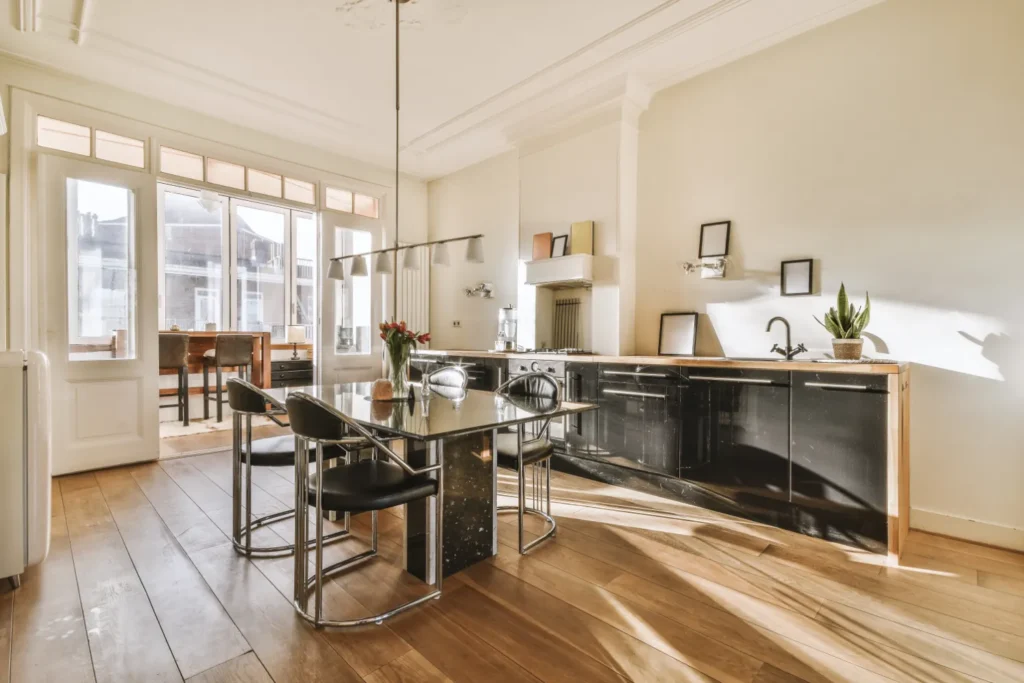
The Role Of Kitchen Furniture In Interior Design
Kitchen furniture isn’t just about tables, chairs, and cabinets; it’s the artistic backbone of your kitchen’s interior design. The way you choose, arrange, and blend these pieces plays a pivotal role in shaping the overall aesthetics and functionality of your kitchen.
Think of your kitchen as a blank canvas, and kitchen furniture as the colors on your palette. Opting for the appropriate furniture can transform the overall atmosphere of your space, be it a desire for a cozy, rustic feel or a contemporary, sleek look. It’s where form and function beautifully intersect. For instance, the choice of a farmhouse-style wooden dining table can instantly infuse a warm and inviting character into your kitchen. Alternatively, contemporary stainless steel bar stools can create a sleek and minimalist vibe. The choice is yours, and it defines the personality of your kitchen.
The Significance Of Material Selection In Creating Timeless Pieces
Material selection is the soul of kitchen furniture design. It’s what separates a mundane kitchen from a timeless masterpiece. The materials you choose impact not only the aesthetics but also the longevity of your kitchen furniture. They are the elements that ensure your pieces stand the test of time.
Consider classic wood as an example. It’s not just a material; it’s a symbol of tradition and endurance. Wooden kitchen cabinets, tables, and chairs exude timeless charm and have a history of withstanding the rigors of daily use. They acquire a beautiful patina over time, telling the story of your kitchen. Conversely, choosing stainless steel ushers in a modern, sleek, and minimalist design perspective. Stainless steel kitchen furniture not only complements contemporary designs but is also incredibly durable and easy to clean. It’s a material choice that promises longevity and a sleek aesthetic.
Essential Factors In Material Selection
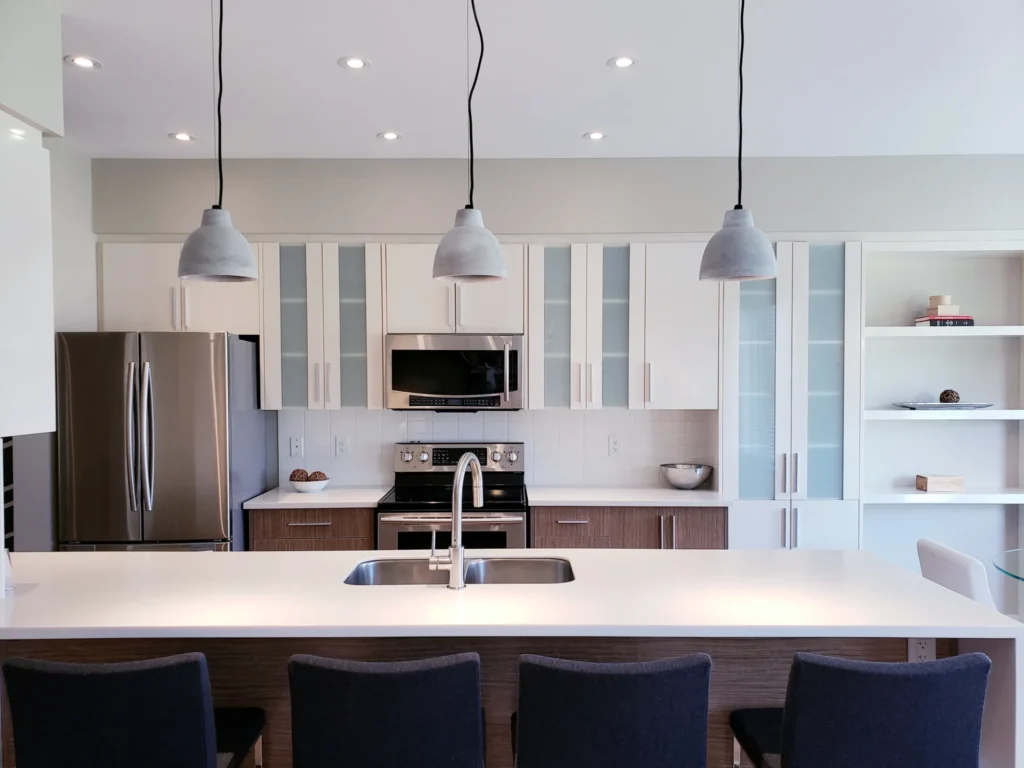
When deciding on the ideal materials for your kitchen furniture, several critical factors come into play:
Endurance: Evaluate a material’s capacity to endure the challenges of your kitchen, from withstanding wear and tear to resisting moisture and stains.
Upkeep: Consider the amount of time and effort you’re prepared to dedicate to cleaning and maintaining the material in question. Some materials require more care than others.
Aesthetic Compatibility: Ensure that your material choice aligns with your overall kitchen design and complements your style preferences.
Eco-Friendliness: In today’s environmentally conscious world, consider materials that are sustainable and eco-friendly.
For instance, if you’re a homeowner with a busy family, you might prioritize durability and easy maintenance. In this case, materials like quartz or granite for countertops could be a practical choice. Interior design professionals, on the other hand, should work closely with their clients to understand their needs, preferences, and lifestyles to make informed material selections that contribute to timeless kitchen designs.
Classic Vs. Contemporary Materials
Timeless Materials For Classic Kitchen Designs
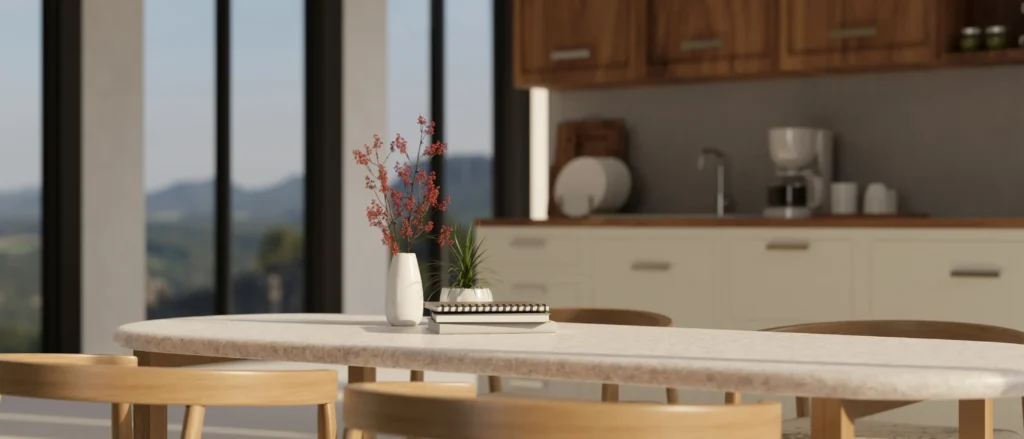
Classic kitchen designs exude a sense of timelessness and nostalgia. When crafting these kitchens, certain materials have proven to be steadfast companions.
Wood: Wood remains the quintessential choice for classic kitchens. Its warm, organic appeal instantly creates a cozy and inviting atmosphere. Wooden cabinetry, tables, and chairs can infuse your kitchen with a rustic charm that transcends trends. The grains and textures of wood lend a unique character to each piece, making it not just functional but a work of art.
Marble: Marble, with its luxurious and timeless aura, is another classic choice. Its veined patterns and smooth surface evoke a sense of opulence. Marble countertops and backsplashes can serve as focal points, adding an elegant touch to your kitchen’s overall design.
Modern Materials For Contemporary Kitchen Furniture
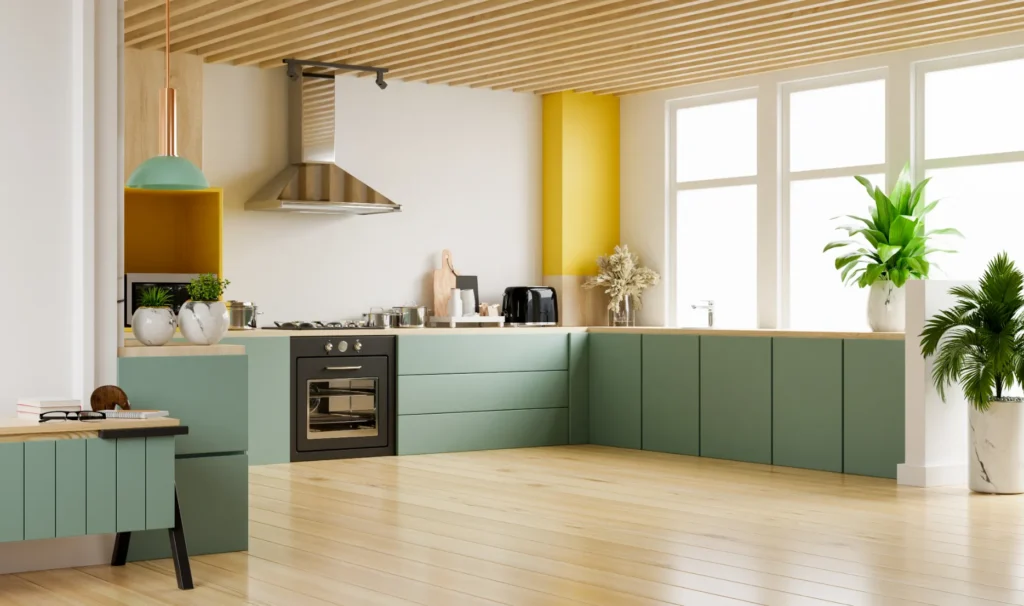
In contemporary kitchen furniture designs, a different set of materials takes center stage. These materials reflect the sleek and minimalist approach of modern aesthetics.
Stainless Steel: Stainless steel is the epitome of contemporary design. It’s not just material; it’s a statement of sophistication and efficiency. Stainless steel appliances, countertops, and fixtures offer a seamless, industrial look. The durability and resistance to corrosion make it ideal for those seeking a sleek, no-fuss kitchen.
Glass: Glass adds an air of transparency and lightness to contemporary kitchens. Glass countertops and cabinet doors create an open and spacious feeling. It can be combined with other materials like stainless steel for a chic and functional look.
Comparing And Contrasting Pros And Cons
When choosing between classic and contemporary materials, it’s essential to consider the pros and cons:
Classic Materials
Pros: Timeless appeal, warm and inviting, often more affordable.
Cons: May require more maintenance, less adaptable to modern designs.
Contemporary Materials:
Pros: Sleek and modern, easy to clean, durable.
Cons: Can feel cold or sterile and may not suit traditional kitchen styles.
For example, if you adore the charm of a classic farmhouse kitchen, the warmth of wooden cabinets, and a marble countertop could be your top choices. However, if you prefer the crisp lines of modern kitchen furniture, stainless steel appliances and glass elements might be more suitable.
Ultimately, your choice should align with your kitchen’s design vision, your lifestyle, and your maintenance preferences. It’s possible to blend classic and contemporary materials, creating a unique and harmonious fusion in your kitchen. The key is to strike a balance that reflects your taste while ensuring that your kitchen furniture remains both stylish and practical.
Durability And Maintenance
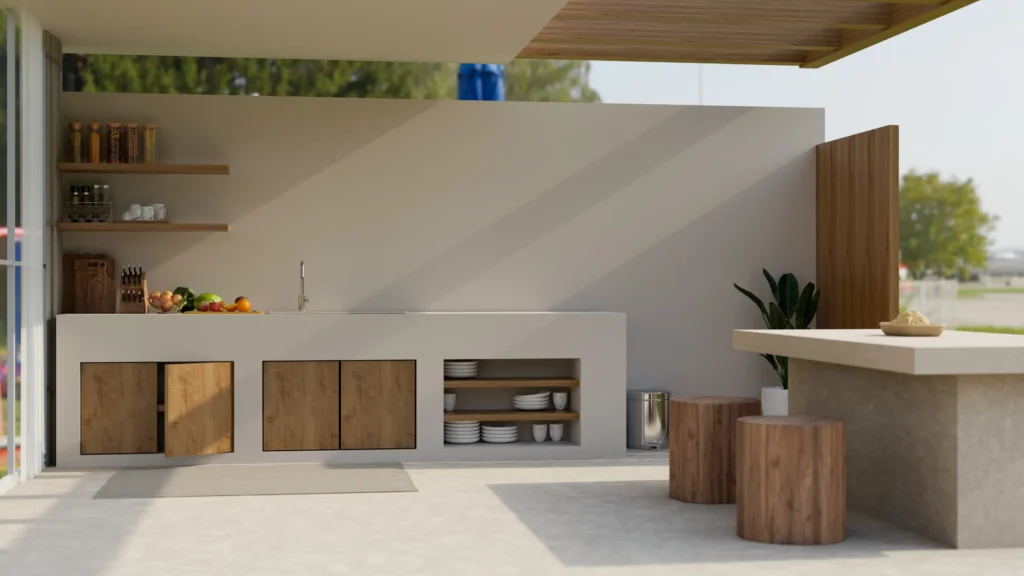
The Longevity Of Materials And Its Impact On Your Kitchen’s Lifespan
When it comes to choosing materials for your kitchen furniture, longevity is a critical factor. The materials you select play a decisive role in determining how long your kitchen will maintain its charm and functionality.
For instance, classic wood and marble are celebrated for their enduring appeal. Wooden cabinets and tables, when cared for properly, can last for generations, becoming heirloom pieces that pass through your family’s history. Marble, while more delicate, can withstand the test of time with proper maintenance.
Conversely, modern materials such as stainless steel and glass provide exceptional durability. They can endure the rigors of daily use and maintain their luster, making them a prime choice for homeowners seeking longevity and low-maintenance kitchen furniture.
Maintenance Requirements For Different Materials
The materials you choose for your kitchen furniture have varying maintenance needs. Understanding these requirements is crucial for preserving the integrity and appearance of your kitchen.
Wood: Regular cleaning and occasional resealing or varnishing are necessary to prevent wear and tear, especially in kitchens with high humidity.
Marble: Marble is susceptible to staining, so sealing it regularly is essential. Wipe spills promptly to prevent permanent discoloration.
Stainless Steel: Stainless steel is virtually maintenance-free. For stainless steel, a routine wipe with a damp cloth and mild detergent typically suffices to preserve its gleam.
Glass: As for glass surfaces, they can be effortlessly cleaned with a specialized glass cleaner or a water and vinegar solution. Be cautious with heavy impacts, as glass can shatter.
Tips For Homeowners To Maintain Their Kitchen Furniture
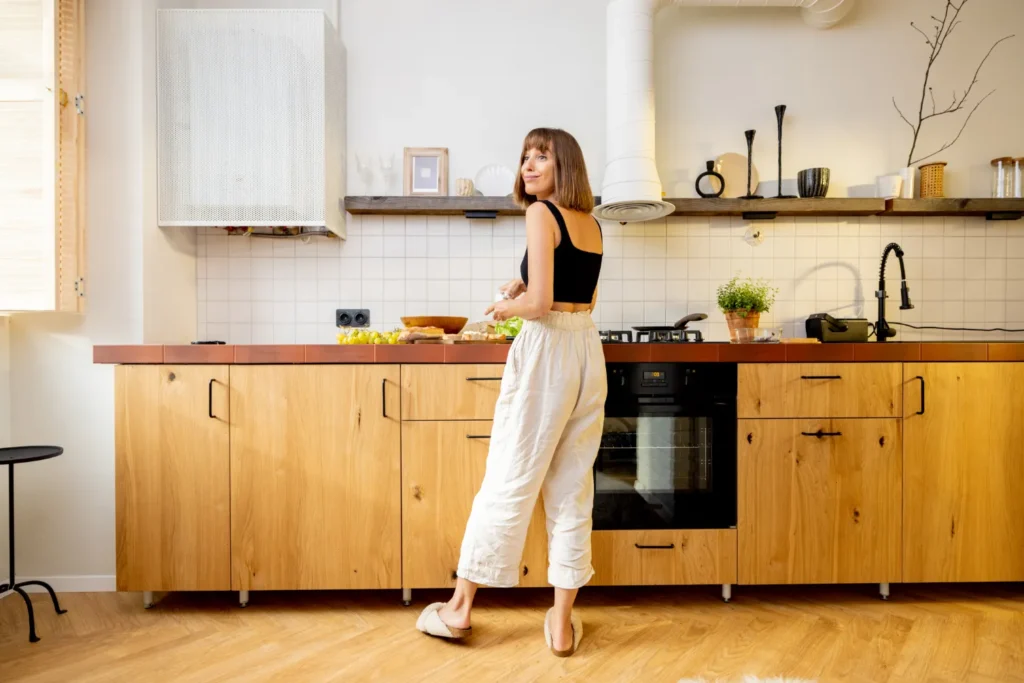
For homeowners, preserving the beauty and functionality of their kitchen furniture is a top priority. Here are some tips to help you maintain your investment:
Regular Cleaning: Develop a cleaning routine to keep surfaces free from dirt and grime. Use appropriate cleaning agents for each material.
Preventive Measures: Use coasters, trivets, and cutting boards to prevent damage from hot cookware and sharp objects.
Re-sealing: If you have wood or marble surfaces, follow manufacturer recommendations for resealing to protect against moisture and stains.
Avoid Harsh Chemicals: Refrain from using abrasive or acidic cleaners on sensitive surfaces like marble and glass.
Inspect for Damage: Regularly inspect your kitchen furniture for signs of wear or damage, addressing issues promptly to prevent further deterioration.
In conclusion, the longevity of your kitchen furniture and the ease of maintenance are closely tied to the materials you select. Understanding the specific requirements for different materials empowers homeowners to protect their investment and extend the life of their kitchen furniture.
Aesthetic Considerations
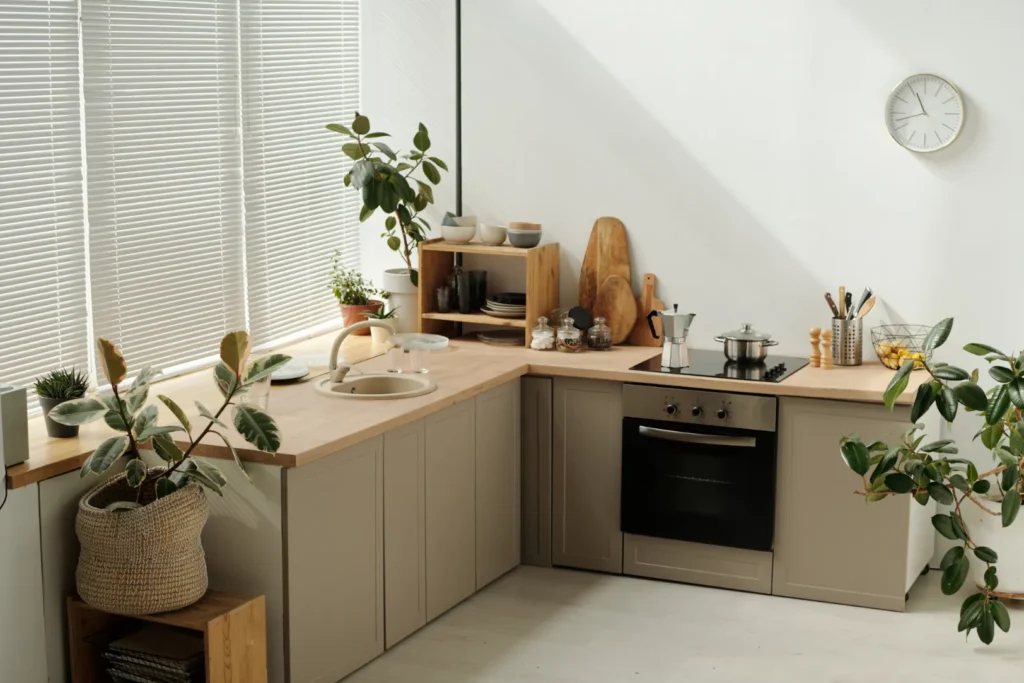
The Visual Impact Of Materials On Kitchen Design
The materials you choose for your kitchen furniture have a profound influence on the overall visual appeal of your kitchen. For example, classic wood exudes a warm and inviting charm. It’s natural grains and textures can create a cozy, rustic atmosphere that’s perfect for traditional kitchen designs.
On the other hand, the reflective surfaces of stainless steel and glass impart a contemporary and minimalist vibe, which aligns perfectly with modern kitchen aesthetics. The visual impact of materials goes beyond aesthetics; it defines the character of your kitchen, making it a place that reflects your unique style and personality.
Matching Materials With Your Home’s Overall Interior Style
Your kitchen should seamlessly integrate with the overall interior style of your home. The choice of materials plays a vital role in achieving this harmonious blend. To ensure your kitchen furniture complements your home’s style, consider the following:
Traditional Homes: Classic materials like wood and marble harmonize beautifully with traditional interiors. They evoke a sense of timelessness that resonates with older architectural styles.
Modern Homes: For contemporary homes, materials like stainless steel and glass offer a sleek and minimalist look that complements modern architecture. These materials can create a cohesive flow throughout your living space.
Transitional Homes: In homes that blend traditional and modern elements, consider mixing materials. For instance, combining wood and stainless steel can bridge the gap between classic and contemporary.
Matching materials with your home’s interior style not only enhances the visual coherence of your space but also elevates the overall appeal and comfort of your kitchen.
Case Studies Of Kitchen Designs That Incorporate Materials Effectively
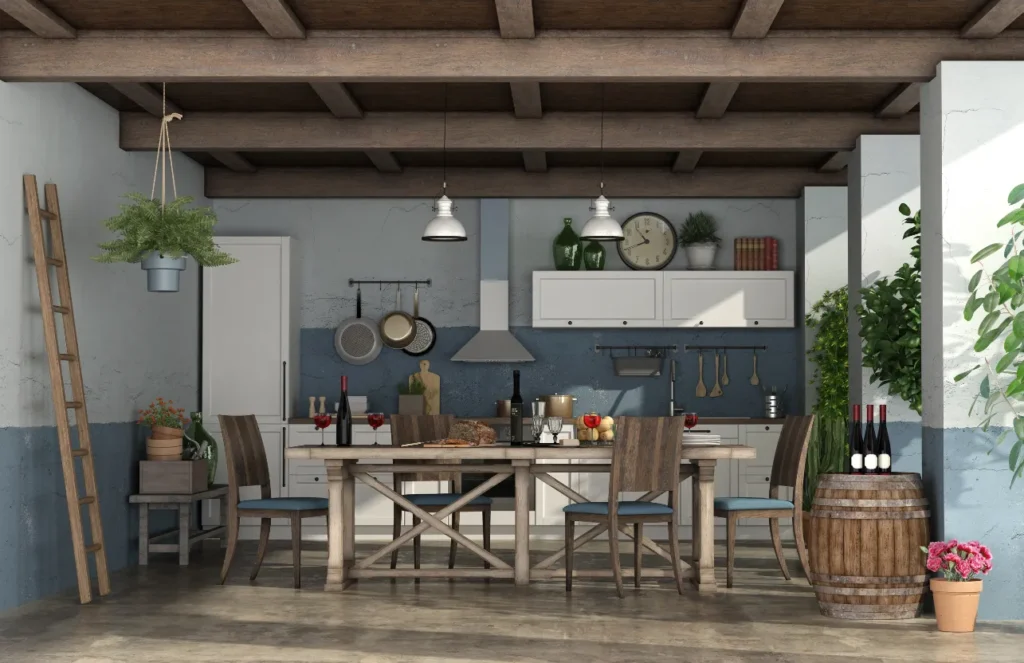
Let’s delve into a few real-life case studies to see how effective material choices can shape stunning kitchen designs:
1: Rustic Elegance In a traditional farmhouse-style home, wooden kitchen cabinets and a farmhouse sink exude rustic charm. The choice of reclaimed wood for the dining table adds character, while marble countertops and a wrought-iron chandelier introduce a touch of elegance.
2: Contemporary Chic For a sleek and modern urban apartment, stainless steel appliances and glass cabinets create a clean, minimalist aesthetic. The use of LED lighting under the glass cabinets enhances the modern ambiance, while a glass-topped dining table adds a touch of sophistication.
3: Transitional Fusion In a transitional home that balances classic and contemporary elements, a combination of wood and stainless steel achieves the perfect fusion. Wood is used for the cabinetry and island, providing warmth, while stainless steel appliances and fixtures infuse a modern touch.
These case studies demonstrate the art of material selection and how it can be tailored to your home’s unique style. By drawing inspiration from these real-life examples, you can craft a kitchen design that seamlessly fits your vision and the character of your home.
Sustainability And Eco-Friendly Options
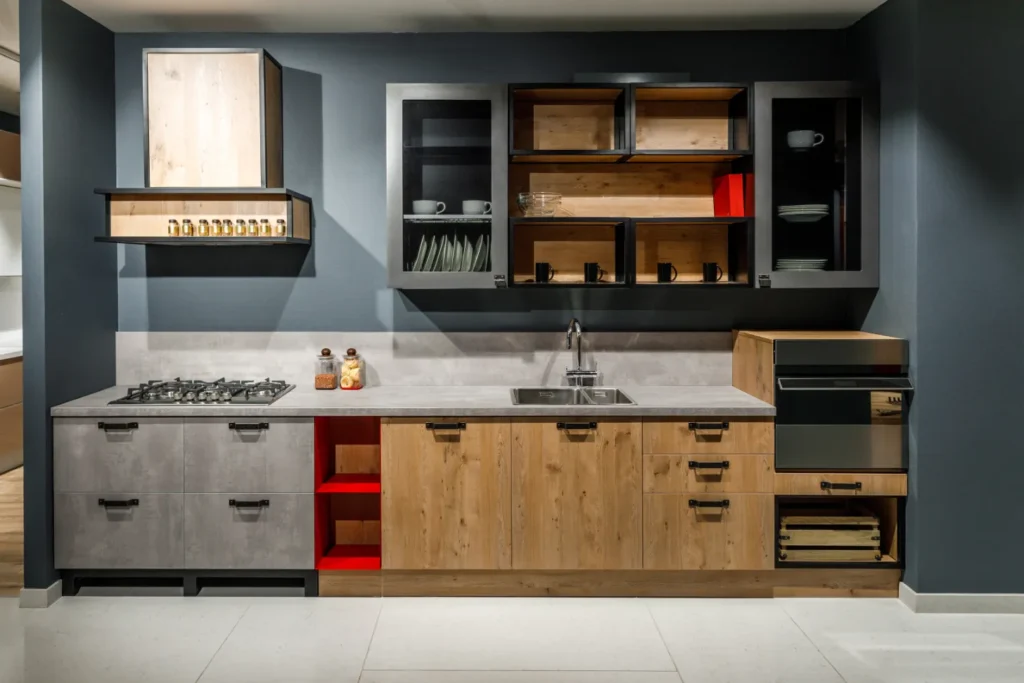
The Growing Importance Of Sustainable Design
In the contemporary landscape, sustainability has transcended mere trendiness; it has evolved into a fundamental tenet of design and a manifestation of our accountability to the environment. In the realm of kitchen furniture and interior design, the significance of sustainable approaches cannot be emphasized enough.
As global environmental awareness increases, homeowners and interior design professionals are embracing the concept of sustainable design. It involves making choices that minimize environmental impact, conserve resources, and promote long-term ecological balance. Sustainable kitchen furniture design is not only an ethical choice but a smart one, as it ensures a healthier planet and a healthier living space.
Highlighting Eco-Friendly Materials And Their Benefits
Eco-friendly materials are at the forefront of sustainable kitchen furniture design. These materials are selected, manufactured, and employed in manners that mitigate environmental impact and bolster ecological well-being. Examples include:
Bamboo: Bamboo is a fast-growing and highly renewable resource. It proves to be an exceptional option for various kitchen furniture applications, ranging from cabinets to flooring, thanks to its durability.
Recycled Materials: Using reclaimed or recycled materials reduces the need for new resource extraction. Recycled glass countertops, for instance, give new life to old glass while creating a stunning kitchen feature.
Low VOC (Volatile Organic Compound) Finishes: These finishes release fewer harmful chemicals into the air, ensuring improved indoor air quality.
The benefits of eco-friendly materials extend beyond environmental responsibility. They often lead to healthier living environments, as they minimize the presence of harmful toxins and promote the responsible use of resources. They are also highly durable, ensuring your kitchen furniture remains a valuable investment for the long term.
How Interior Design Professionals Can Promote Sustainability

Interior design professionals play a pivotal role in advancing sustainable design practices. They can promote sustainability by:
Education: By staying informed about eco-friendly materials and sustainable design principles, professionals can guide clients toward responsible choices.
Material Selection: Recommending sustainable materials to clients, such as reclaimed wood or low VOC finishes, can make a significant impact on the environment.
Local Sourcing: Encouraging the use of locally sourced materials and products reduces transportation-related emissions and supports the community.
Energy Efficiency: Suggesting energy-efficient appliances and lighting solutions can lower a kitchen’s environmental footprint.
Incorporating sustainable design practices into kitchen furniture and interior design not only benefits the planet but also adds value to your home.
Budgetary Constraints

Cost Implications Of Different Materials
One of the critical factors to consider when selecting materials for your kitchen furniture is the cost. Different materials come with varying price tags, and it’s essential to understand the financial implications. For instance, high-end materials like solid wood or natural stone can be more expensive than alternatives such as laminate or composite materials. It’s vital to weigh the cost against your budget to make informed decisions.
Strategies For Homeowners To Balance Budget And Quality
Balancing budget and quality is a common challenge for homeowners embarking on kitchen furniture projects. Here are some strategies to find that equilibrium:
Prioritize: Identify key areas where you want to allocate a significant portion of your budget, such as countertops or cabinetry. In less prominent areas, consider more budget-friendly options.
Explore Alternatives: Look for cost-effective materials that mimic the appearance of pricier ones. For instance, engineered stone countertops can offer the look of natural stone at a lower cost.
Shop Smart: Keep an eye out for promotions, discounts, and sales events. Seasonal sales can help you secure high-quality materials at reduced prices.
Recommendations For Interior Designers When Working Within Budget Constraints
Interior designers are experts at turning limitations into opportunities. When working with clients who have budget constraints, consider the following:
Consultation: Begin by discussing your client’s budget and expectations. Clear communication can help set realistic goals.
Value Engineering: Explore cost-effective alternatives for materials and finishes without compromising the design’s integrity.
Local Sourcing: Opt for locally sourced materials to reduce transportation costs and support the community.
Customization: Design custom solutions that maximize the use of materials and minimize waste, thereby saving costs.
Balancing budget and quality is a delicate art in kitchen furniture design. While cost implications vary with material choices, smart strategies and creative solutions enable homeowners and interior designers to create stunning kitchens that align with financial realities.
If you are looking to give a fresh look to your Living Room, also Read: 51 Luxury Living Rooms And Tips You Could Use From Them
Conclusion

In the intricate realm of kitchen furniture design, where materials serve as both the foundational structure and the finishing flourish, each decision presents an opportunity to craft a masterpiece. From timeless selections like wood and marble to the contemporary allure of stainless steel and glass, we’ve delved into the influence of materials in shaping both the appearance and functionality of your kitchen. Whether you aspire to cultivate a warm, traditional atmosphere or embrace a sleek, modern ambiance, your choice of materials constructs the narrative of your kitchen tale.
Furthermore, we’ve underscored the ever-mounting importance of sustainable and eco-friendly options, recognizing the collective responsibility we hold in preserving our environment. Opting for environmentally conscious materials not only results in aesthetically pleasing kitchens but also plays a role in nurturing a planet that’s more sustainable and healthier.
Additionally, we’ve successfully navigated the complexities of harmonizing budget constraints with quality, offering homeowners practical strategies and presenting interior designers with valuable recommendations to craft exquisite kitchens while respecting financial boundaries.
In the ever-evolving realm of kitchen furniture design, the pivotal role of material selection persists. Each selection possesses the potential to metamorphose kitchens into not just utilitarian spaces, but genuine works of art, adding richness to our lives and our homes for years to come. As you embark on your individual kitchen design expedition, keep in mind the limitless possibilities, and recognize that the skill of material selection is your most potent instrument for forging kitchens that endure the trials of time.
At The White Frame, we turn extravagant dreams into functional, well-crafted realities. We handcraft luxurious homes, tailored to the preferences of our diverse clientele in Gurgaon, Noida, and Delhi NCR. We’re redefining the notion of modern opulence, proving that luxury doesn’t have to strain the budget. We’re driven by a core belief that our in-house technology streamlines processes, making the journey to your dream home effortless and trouble-free. Our team of designers is well-versed in optimizing space, crafting functional, aesthetically pleasing interiors that exude class, sophistication, and beauty.
Explore some of our work here!









